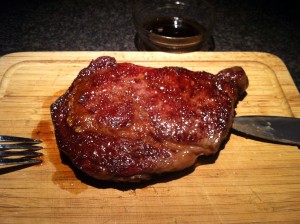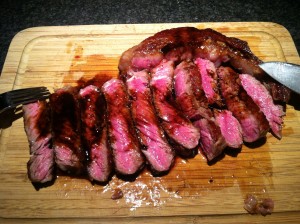
The tricky thing about cooking a good steak is that it’s almost all about preparation, so this “recipe” is going to be a little different. The most useful tweaks in cooking a great steak are: letting it come to room temperature, seasoning liberally before cooking, and letting it rest after cooking. I’ve also included a recipe for a soy-balsamic reduction that jazzes up the steak a bit. It’s a bit more labor-intensive than your standard cooking method, and it certainly requires a bit of planning, but it is hard to screw up if you cook it this way.
A note: the cooking times below (3 minutes/side) will get you to rare/medium-rare on an inch-thick steak. For medium-rare, go 4 minutes on the first side and 3 minutes on the flip. Medium should take you about 4/4 You should also know that, once you get to medium, it cooks REALLY fast. So err on the side of undercooking, because the steak will continue to cook while you let it rest. Finally, if you plan to go for well-done, this recipe is not for you.
INGREDIENTS
– Two tablespoons (or so) of canola oil
– A tablespoon or two of butter
– A steak, at least an inch thick and well-marbled (I like ribeye)
– Kosher salt
– Cracked black pepper
– Soy sauce
– Balsamic vinegar
– One sprig fresh rosemary
RECIPE

1. When buying a steak, be sure to pick one that’s about an inch thick. This’ll allow you to control the internal temperature of the steak while still getting that tasty, caramelized crust. You also want to pick one that has a good amount of marbling (fat streaks in the meat) because it should signify a more tender, flavorful steak.
2. Take the steak out of the fridge an hour prior to cooking. Pat it dry on both sides and season it liberally with kosher salt. Let it rest for an hour.
3. Heat a cast-iron skillet (or regular frying pan, if you don’t have one) until it’s hot. Pour in the canola oil and butter and stir constantly – you want the butter to brown but not burn.
4. Put the steak in the middle of the pan and then immediately tip the pan downwards (towards you) at a slight angle so the fat and juices pool towards you. Quickly and continuously baste the top of the steak with the pooled butter/oil/juices – you should see the top surface start to turn gray. Do this for three minutes (see note above).
5. Flip the steak – you should see a well-caramelized surface – and do the same for the three more minutes, then immediately put it on a plate or chopping board. Let it rest for five minutes while you prepare the sauce.
6. Pour off most of the fat from the pan, then return it from the heat. Place the whole rosemary sprig in the pan so it starts to fry in the residual fat for about thirty seconds, then pour in several generous glugs of balsamic vinegar and several splashes of soy sauce (roughly 2:1 or 3:1 balsamic to soy sauce). Lower the heat to medium, take out the rosemary sprig, and season the sauce with cracked black pepper while it reduces. If you want to thicken the sauce a little bit, put in a little bit of butter and stir vigorously.
7. Slice the steak into strips and then drizzle it with the reduced sauce.






